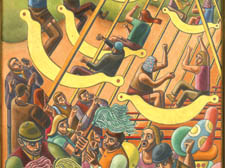|
|
 |
| |

Hampstead fairs, by William Roberts, 1951 |
Posters that expanded London
Dan Carrier reviews a new exhibition of a century of graphics that sold the capital’s Tube system to its people
IT has been 100 years since the first poster was slapped up with wallpaper paste on the platforms of the Tube.
Selling Hampstead to travellers as “the nearest point to London for fun and fresh air”, these new Tube posters subtly suggested Londoners should get out and explore their city – by London Underground, of course.
To celebrate the centenary, Covent Garden’s London Transport Museum is hosting an exhibition that covers 100 years of graphic art – and charts the changing trends and fashions in British art through the 20th century.
The brains behind the posters was Frank Pick, the publicity officer for the Underground. Curator Claire Dobbin, who has recently completed cataloguing 5,000 posters, says Pick’s appointment changed the way graphic design was used to sell products. The first poster was designed by John Hassell – a well-established commercial designer.
“Before then, posters were always text-based,” she says. “Using art and design was modern, and was a new approach to publicity at the time.”
Pick took a subtle “soft sell” approach. He saw that by marketing things in and around London – destinations, events, the theatre – you were getting people out and using public transport. “It was a whole range of subjects and worked well graphically,” says Ms Dobbin. “You could not even mention the Tube – you just have to say the destination.”
The new Tube network needed extra customers during the off-peak hours, hence Pick’s designers’ adverts for football matches and the theatre.
He cast his net wide – he wanted well-established artists, commercial designers and those up-and-coming young talents who represented contemporary graphic art.
Ms Dobbin said: “It gave the Tube a range of styles, and they were very well received.”
Pick understood how important the posters were and ensured they were saved for posterity. As well as seeing to it that the Underground kept an archive, he also sent originals to the V&A, aware they offered a month by month account of the trends in 20th-century poster design.
The posters had a second role to play. While today we take the Tube for granted, for early users there could be something daunting about heading down an escalator – a new-fangled idea in itself – climbing aboard a train under the streets of London and being whisked at high speed along to another part of town. People were fearful and distrusted the idea – Pick’s teams were given the job of making the Tube seem modern, friendly, easy-to-use and risk free.
Posters mark the expansion of London – the growth of the suburbs were possible because of new tube lines.You could live in a new house where there were once just fields and then zoom into town for work or leisure. The Tube would not have been this social catalyst if Frank Pick’s artists had not sold the idea so well.
•
 |
| |
|
 |
 |
|
 |
|



